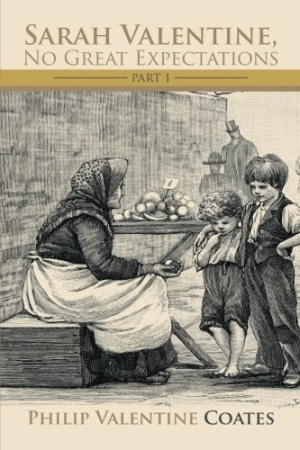Sarah Valentine, No Great Expectations: Part 1
This biography sheds light on what life was like on the rough streets of nineteenth-century London.
In Sarah Valentine, No Great Expectations: Part 1, Philip Valentine Coates begins the three-part story of his great-great-grandmother’s life on the squalid streets of nineteenth-century London.
The story follows Sarah through the alleys, pubs, docks, and workhouses of London’s east side between 1819 and 1837, from her birth until she turns eighteen. The book is well researched, giving it a documentary feel.
In the introduction, the author promises a chronology as opposed to a story with an arc. Yet Sarah’s story does have an arc, and it’s an interesting one. By the age of seven, she’s a pickpocket and a heavy drinker, working the street markets for an older girl.
As Sarah matures, her circumstances change. When she’s twelve years old her parents, unable to cope with her behavior, leave her at a workhouse, where she is beaten, humiliated, and left to fend for herself. While there, she begins helping other children, and that starts to soften her. It is at the workhouse where she makes a few friends and learns the washing and drudge work skills she will need when she finds herself on her own towards the end of the book.
Characterizations are clear, especially of Sarah and her father Jim, who tries and fails to care for his family, though he abuses Sarah from the beginning. When seven-year-old Sarah comes home drunk, he kicks his daughter out of the two-room flat they share with three other families. She sleeps it off in the snowy street with rats and beetles, a horror that sets the scene of East London early in the story. Later, when Sarah’s younger sister Charlotte picks up Sarah’s drinking and thieving habits, Sarah is remorseful at seeing her own example in her sister’s ruin.
Coates creates a realistic picture, though sometimes it is overdone. A background of vermin, feces, starvation, violence, and suffocating smells is overemphasized. Characters shift from place to place in a way that feels repetitive, with the descriptions of the routes they take losing appeal as the book progresses.
Punctuation and spelling errors are also a distraction. Much of the dialogue is written in Sarah’s local dialect, which works to further set scenes, though in some cases, as with the relieving officer and the parish beadle, expository conversations are awkward.
Sarah Valentine, No Great Expectations: Part 1 creates a vivid view of the seedy streets of Sarah’s world. Fans of the Dickensian era will find it to be well researched. Through Sarah’s plight, Coates sheds light on the misery of nineteenth-century Whitechapel, where each person was an individual with a story, and most were doomed never to rise to a better life.
Reviewed by
Petrea Burchard
Disclosure: This article is not an endorsement, but a review. The publisher of this book provided free copies of the book and paid a small fee to have their book reviewed by a professional reviewer. Foreword Reviews and Clarion Reviews make no guarantee that the publisher will receive a positive review. Foreword Magazine, Inc. is disclosing this in accordance with the Federal Trade Commission’s 16 CFR, Part 255.

